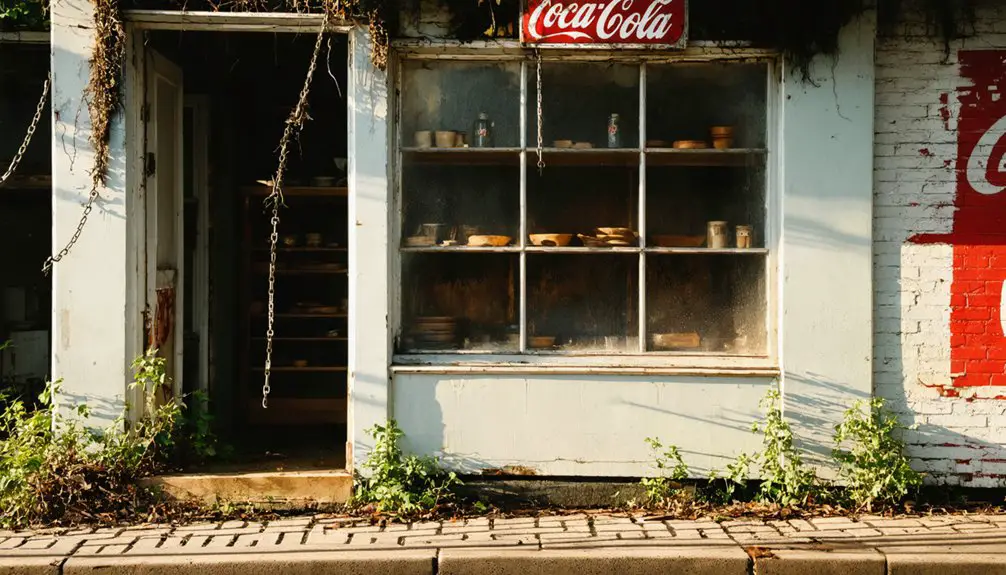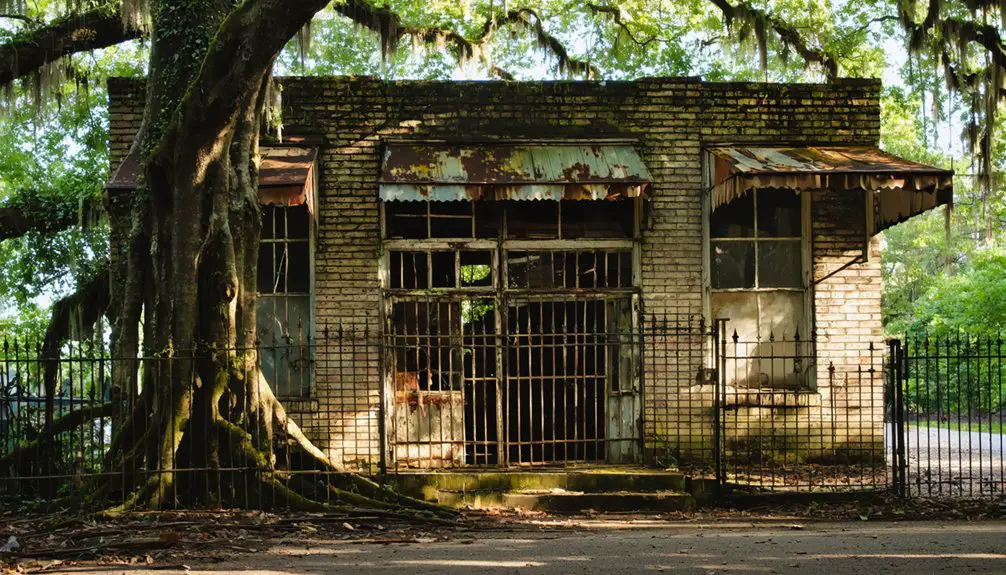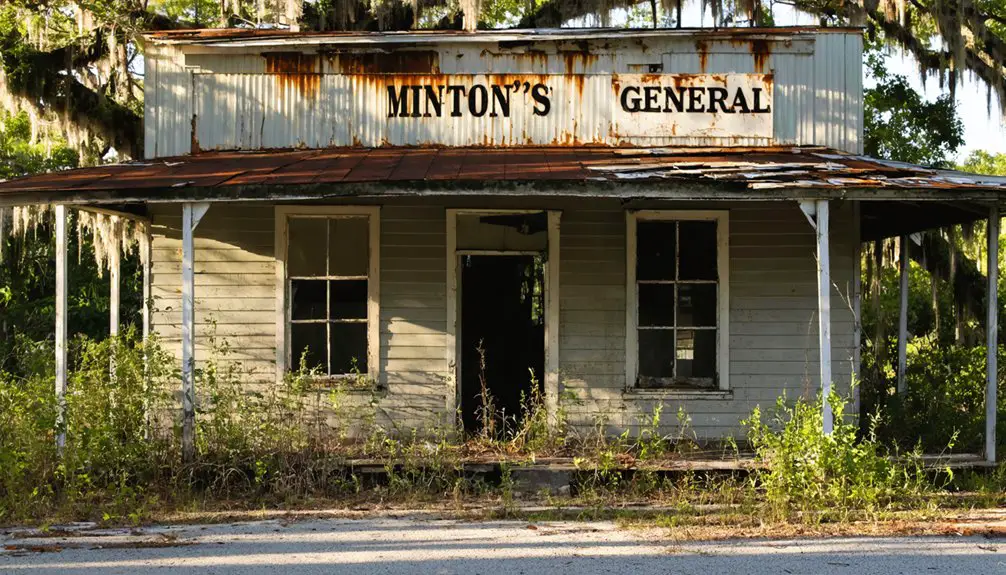You’ll find Minton’s Corner in Brevard County, Florida at 28°4.7’N, 80°40.3’W, where a bustling lumber town once processed 60 acres of timber daily. The settlement thrived in the early 1900s with steam-powered sawmills, company housing, and a tight-knit community, but couldn’t survive the triple blow of agricultural struggles, the Spanish-American War, and the Great Depression. Today, coastal erosion and dense vegetation have reclaimed most structures, leaving scattered remnants that tell a deeper story.
Key Takeaways
- Minton’s Corner was a thriving Florida lumber town that became a ghost town after economic decline triggered by the 1929 Great Depression.
- Located in Brevard County at 28°4.7’N, 80°40.3’W, the town processed up to 60 acres of timber daily through steam-powered sawmills.
- The community’s decline accelerated when essential railroad services were rerouted, isolating the town and causing rapid collapse of local commerce.
- Natural forces, including hurricanes and coastal erosion, have reclaimed most structures, leaving only scattered industrial debris and old foundations.
- The town’s economy centered around a sawmill paying 10.5 cents per hour, with nearly 1,000 workers employed by 1928 before abandonment.
The Rise and Fall of a Lumber Town
While many Florida lumber towns emerged in the early 20th century, Minton’s Corner stood as a prime example of the era’s industrial development.
You’d find a bustling community built around vast longleaf pine forests, where steam-powered sawmills processed timber at unprecedented rates, reaching 60 acres per day at peak production.
The lumber industry transformed this remote area into a self-contained society, where companies provided housing, schools, and medical facilities.
Workers, mostly rural white men with farming backgrounds, adapted to industrial work life as production soared.
The town’s output contributed to South Florida’s impressive lumber statistics, which doubled to over 3.2 billion board feet by 1879.
A strong community identity emerged as families settled into company-provided amenities, though their prosperity would ultimately depend on the finite timber resources surrounding them, mirroring the timber depletion that had occurred centuries earlier in the British Isles.
Working conditions were harsh, with laborers earning just 13.67 cents per hour while facing dangerous conditions and long workdays.
Geographic Features and Natural Challenges
As you explore Minton’s Corner‘s geographic setting in Brevard County, Florida, you’ll find it situated at 28°4.7’N latitude and 80°40.3’W longitude, where flat terrain meets a complex mixture of forests and wetlands.
The site’s geographic isolation intensifies due to natural erosion and dense vegetation that rapidly reclaims abandoned structures, while coastal influences contribute to accelerated decay. Similar to the Florida-Georgia line region, the area faces challenges with overgrowth overwhelming historic structures. The constant battle against nature reflects how human existence in Florida requires perpetual maintenance against encroaching elements.
Nature steadily erases human presence through relentless erosion, encroaching vegetation, and the destructive touch of coastal elements.
- Hurricane-force winds and flooding regularly batter structures, making maintenance costly
- Sea air’s corrosive salt content deteriorates buildings and metal infrastructure
- Native vegetation like saw palmettos and live oaks creates impenetrable thickets
- Sandy, organic-rich soils combine with poor drainage to create swampy conditions
The nearby ridges provide limited elevation, but the surrounding lowlands remain susceptible to flooding and water retention during Florida’s frequent storms and heavy rainfall.
Life in Early Minton’s Corner
Life in early Minton’s Corner centered around the sawmill, where workers spent their days logging and processing lumber in what was then the town’s economic backbone.
You’d find residents gathering at the general store-cum-post office to collect mail and exchange news, forming the heart of daily social interactions.
After church services on Sundays, families would often visit each other’s homes for communal meals and socializing, maintaining strong community bonds despite the challenges of frontier living. Like modern social media where shortcuts for navigation help users move efficiently through content, the townsfolk developed their own ways to navigate their close-knit community.
The local artisans utilized natural resources creatively, harvesting and processing Spanish moss to create comfortable pillows for their homes.
Daily Community Activities
During the early days of Minton’s Corner, daily community activities centered around several key gathering places that formed the social backbone of the town.
You’d find locals congregating at the general store, which served as both a trading hub and social center. Community bonding flourished through seasonal celebrations, religious services, and impromptu gatherings, while essential daily commerce kept the town’s pulse beating strong. Like many Florida ghost towns, the population declined sharply after the devastating Big Freeze of 1894-95. Similar to the Mayaca-Jororo people who once inhabited Central Florida, the town’s residents maintained strong community ties through shared gatherings and customs.
- The general store doubled as a marketplace and news exchange, where you could barter goods or catch up on local happenings.
- Religious services brought folks together in multi-purpose buildings that also served as schools.
- Family networks shared childcare duties and pitched in with farming tasks.
- Evening socials featured storytelling, music, and craftwork, strengthening neighborhood ties.
Work at the Sawmill
When Minton’s Corner’s sawmill first opened its doors, workers faced challenging conditions while processing thousands of board feet of lumber daily. You’d find men, both black and white, who’d left farming behind for the promise of steady sawmill labor, even though the pay was just 10.5 cents per hour.
Working conditions weren’t easy – you’d spend long days operating heavy machinery or manually hauling timber in a high-risk environment. Slave labor was extensively used at the facility under the management of Forsyth and Simpson Firm. The site grew rapidly to accommodate nearly one thousand workers after the sawmill was announced in 1928.
The mill’s operations relied on complex systems of temporary railways and log flumes to transport timber from the vast pine forests. You’d see mules pulling loaded cars along tracks that workers would extend or dismantle daily.
Worker safety became such a pressing concern that by the early 1900s, the industry launched campaigns to protect its laborers from the dangerous machinery and hazardous conditions.
Church and Social Gatherings
As the heart of Minton’s Corner’s social fabric, churches served multiple essential roles beyond spiritual gatherings. You’d find these buildings doubling as community centers, schools, and meeting halls, fostering social cohesion among diverse pioneer families.
Church functions ranged from religious services to educational activities and celebrations, with ministers and elders guiding both spiritual and civic matters.
- Weekly potlucks and seasonal festivals strengthened bonds between residents
- Live music and dancing brought entertainment to the multipurpose church halls
- Informal job networks and community support systems emerged during gatherings
- Storytelling sessions preserved cultural heritage and local traditions
Despite economic hardships and natural disasters that occasionally disrupted these gatherings, church-centered social events remained important to maintaining community spirit until the town’s eventual abandonment.
Economic Struggles and the Great Depression

You’ll find that Minton’s Corner’s economic decline began well before the Great Depression, with the community facing hardships after 1898 as local agriculture struggled and transportation routes shifted.
When the Depression hit in 1929, it devastated what remained of the town’s fragile economy, with plummeting crop prices and bank failures forcing many residents to abandon their farms and businesses.
The final blow came as essential railroad services were rerouted away from the settlement, effectively isolating the community and accelerating its transformation into a ghost town.
Economic Downfall After 1898
The Spanish-American War of 1898 triggered a devastating economic cascade throughout Florida that hit Minton’s Corner particularly hard.
You’ll find that agricultural challenges plagued local farmers as they struggled with tobacco cultivation experiments and significant crop losses. Trade disruptions intensified when railroad depots faced repeated rebuilding, while ferry operations fought to maintain essential commerce links.
- Tobacco farmers’ attempts to grow Cuban and Sumatran varieties yielded disappointing results
- Corn yields dropped by 20% due to environmental stresses
- Railroad depot fires crippled transportation infrastructure
- Land speculation around transport hubs reflected desperate attempts to maintain economic relevance
The war’s aftermath reshaped regional priorities, leaving Minton’s Corner vulnerable to market changes and infrastructure instability.
Local farmers watched their traditional crops fail while cattle and citrus operations suffered from northern colonial expansion and militia presence.
Depression’s Final Community Blow
While Minton’s Corner had already weathered significant economic challenges by 1929, the stock market crash delivered a devastating blow to this fragile community.
You’d have witnessed the rapid collapse of local commerce as bank failures wiped out residents’ savings and deflation crushed business activity.
The town’s troubles intensified when Florida’s citrus industry, already reeling from a Mediterranean fruit fly infestation, saw production plummet by 60%.
Community resilience crumbled as essential services faltered, infrastructure deteriorated, and tax revenues disappeared.
The combined effects of hurricanes in 1926 and 1928 had already damaged farmland and buildings, leaving little buffer against the Depression’s impact.
Rural migration accelerated as desperate families abandoned their homes, seeking work in urban areas or other states, effectively sealing the town’s fate.
Environmental Impact on Settlement
Located in a hurricane-prone region of Brevard County, Minton’s Corner faced devastating environmental challenges that ultimately contributed to its decline. The settlement’s environmental resilience was repeatedly tested by powerful storms like Milton and Helene, which caused extensive structural damage and prolonged power outages.
Poor stormwater management and unregulated development further weakened the area’s natural defenses against disasters.
- Category 1-4 hurricanes regularly battered structures, leaving homes uninhabitable and infrastructure compromised.
- Storm surges and flooding disrupted access to essential resources, isolating the community.
- Polluted runoff from impervious surfaces contaminated local waterways and degraded ecosystem health.
- The combination of hot summers and frequent tropical storms challenged agricultural productivity and long-term settlement viability.
Historical Legacy and Modern Remnants

Since its abandonment in the early 20th century, Minton’s Corner has left behind a sparse physical legacy that mirrors many forgotten Florida settlements.
You’ll find few remnants of the town’s existence today, with nature having reclaimed most structures and no formal historical preservation efforts in place. The town’s cultural significance lives on primarily through its connection to Confederate veteran John Minton Lord and local folklore.
Time and neglect have erased Minton’s Corner, leaving only whispered stories of John Minton Lord and his Confederate past.
If you explore the area, you might discover scattered industrial debris, old foundations, or weathered signage, though identifying exact locations proves challenging.
Like many ghost towns of its era, Minton’s Corner represents the fleeting nature of early Florida pioneer settlements, where economic hardships, natural disasters, and changing times led to their eventual abandonment.
Frequently Asked Questions
Were There Any Notable Crimes or Lawlessness Reported in Minton’s Corner?
You won’t find documented crime rates or law enforcement records showing notable lawlessness in this area. Historical evidence suggests the town’s decline followed typical economic patterns rather than criminal activity.
What Native American Tribes Originally Inhabited the Area Before Minton’s Corner?
You’ll find Creek culture dominated the region initially, with various Muskogean-speaking groups present. Later, the area became part of Seminole heritage through migrations and cultural blending in the 18th century.
Did Any Famous People or Historical Figures Visit Minton’s Corner?
You won’t find records of famous visitors in this town’s history. While Confederate veteran John Minton Lord shares a name connection, there’s no evidence of historical figures making significant visits here.
What Happened to the Cemetery and Burial Grounds After Abandonment?
You’ll find the cemetery fell victim to neglect, with floods and storms destroying markers while subtropical vegetation consumed burial grounds. Without preservation efforts, these historic sites vanished into Florida’s changing landscape.
Were There Any Attempts to Rebuild or Revive the Town After 1900?
You won’t find any documented revival efforts after 1900 – the sawmill’s destruction, persistent flooding, and the Great Depression’s impact effectively sealed the town’s fate, erasing its historical significance for generations.
References
- https://www.tiktok.com/@socialshepherdadventures/video/7342301852702100778
- https://www.youtube.com/watch?v=kXGAKmjGMXg
- https://www.ocalastyle.com/ghost-towns-of-marion-county/
- https://floridahistoryblog.com
- https://en.wikipedia.org/wiki/List_of_ghost_towns_in_Florida
- https://www.srs.fs.usda.gov/pubs/gtr/gtr_srs257.pdf
- https://www.fnai.org/arrow-site/history/history-forestry
- https://stars.library.ucf.edu/cgi/viewcontent.cgi?article=4132&context=fhq
- https://en.wikipedia.org/wiki/History_of_the_lumber_industry_in_the_United_States
- https://www.youtube.com/watch?v=8QapC-yk4Bo



